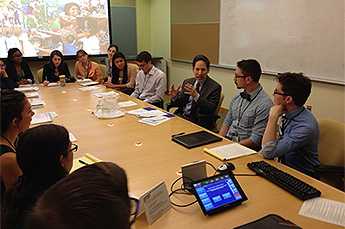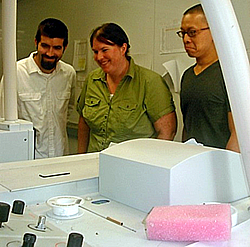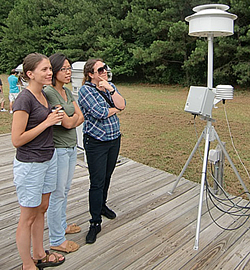Projects
Interns are placed in projects that are appropriate for their skill set and previous experiences. This page represents some of the varied projects that GEH interns have undertaken in past years. The projects will change from year to year, but this page will give you an idea of the varied types and caliber of potential projects.

Project: Water quality issues in partner states and counties of the CDC/NCEH’s Private Wells/Unregulated Drinking Water Systems Program
Almost 13 million homes in the U.S. are served with private wells or other federally unregulated drinking water systems (systems that serve less than 25 people or have less than 15 connections). However, little is known about the water quality of most of these systems, their vulnerabilities to contamination, and the human health threats to which users of these systems are exposed to. Thus the Emergency and Environmental Health Services Branch (EHSB) is leading Private Well/Unregulated Drinking Water Systems Program to address this issue. EHSB has partnered with state and county health departments to identify water quality and public health issues related to these systems. The GEH intern conducted an in-depth and systematic review of the information on water quality issues that project partners have reported. The focus was on partners’ work that have influenced or have the potential to influence policy. One partner successfully amended policy regarding well drilling rules and well water testing for arsenic. The work of five other partners have the potential to influence policy directed to protect human health among private well owners. This information is helping EHSB determine successful outcomes of the Program.
Project: Environmental Health Impact Statements and Cross-Center Evaluation Collaborative
The NCEH/ATSDR Office of Policy, Planning, and Evaluation (OPPE) supports CDC’s environmental health programs by coordinating cross-cutting policy, budget, and performance initiatives. The intern worked closely with staff in OPPE and staff from the Environmental Public Health Tracking Network to develop environmental health impact statements. The intern conducted a program data inventory and literature review to develop statements about the public health impacts and cost of the Tracking program’s activities. These impact statements will be used in important documents and responses to Congressional members, partners and others to communicate about the importance of the Tracking program.
Additionally, in response to requests from NCEH/ATSDR evaluators for Center-wide opportunities to collaborate with one another and share resources and information about evaluation, the intern gathered background information about forming an evaluation community of practice (CoP) in NCEH/ATSDR by conducting informational interviews, a brainstorming session, and a survey to collect information about the needs and interests of evaluators. The intern drafted a report of findings that have helped the Center determine how best to plan and implement creation of this first-ever Center-wide evaluation CoP.
Project: Positioning the CDC to Evaluate Potential Health Impacts of U.S. Marine Port Modernization
Major expansion of the Panama Canal is underway and is expected to affect U.S. ports, potentially affecting air quality in the communities surrounding the ports. One GEH intern worked with the Air Pollution and Respiratory Health Branch of the National Center for Environmental Health in collaboration with the Environmental Protection Agency to research ways to characterize the environmental, economic, and community characteristics of ports in the U.S. via gathering data about port expansion plans, evaluating existing environmental monitoring near the ports, describing the industrial activities at each port, and summarizing characteristics of the surrounding communities. This intern developed a 31 page document to describe what information exists, capture the primary approaches/strategies, and provide sources for further information. The intern also drafted a Characterization of Individual Ports spreadsheet to begin capturing individual information on select major ports.

Project: Windows of Sensitivity During Development: Endocrine System
One GEH intern worked on a toxicology project for the Agency for Toxic Substances and Disease Registry (ATSDR). The aim of the project was to identify developmental windows of sensitivity to chemicals affecting endocrine endpoints. This included reviewing and assessing over 170 toxicology profiles from the ATSDR website, as well as over 40 recent addenda to those profiles. Further literature searches pertaining to the topic were performed in the PubMed database. The intern summarized the results in tables and a heat map identifying the sought after windows of sensitivity. Based on the results, conclusions were drafted. The work on the project will continue and potentially culminate in a published paper.
Project: Computational Toxicology Modeling of Health Guidance Values as a Screening Tool for Emergency Response Situations
Environmental health assessment and environment remediation actions are based off of chemical-specific exposure levels known as Health Guidance Values (HGVs). The Agency for Toxic Substances and Disease Registry (ATSDR) develops minimal risk levels (MRLs) that contribute to the development of HGVs. HGV development is a time- and resource-consuming process. Until now health guidance has been available only for a handful of chemicals. Thousands of chemicals in manufacturing, trade and commerce, and at hazardous waste sites across the Nation do not have HGVs. The ATSDR Computational Toxicology laboratory develops computational models for derivation of provisional HGVs (pHGVs) that can be used in place of vetted HGVs when the latter are unavailable. The models rely on a method of quantitative structure-activity relationship (QSAR) modeling, which relates the chemical structure to toxicity of the chemical. The intern participated in the development of a database, data analysis, and QSAR modeling for oral and inhalation chemical exposure models.
Project: Comparing ATSDR Minimal Risk Levels with the European Union DNELs (Derived No Effect Level)
The Agency for Toxic Substances and Disease Registry (ATSDR) develops minimal risk levels (MRLs), health-based guidance values derived for many substances that are on the list of hazardous substances most commonly found at facilities on the National Priorities List (NPL). An MRL is an estimate of the daily human exposure to a hazardous substance that is likely to be without appreciable risk of adverse non-cancer health effects over a specified duration of exposure. Similarly, the European Commission’s Registration, Evaluation, Authorization and Restriction of Chemicals (REACH) program requires risk characterization of substances by using a newly developed health benchmark, called the Derived No Effect Level (DNEL). Calculations of DNELs, similarly to the MRLs, require judgment regarding selection of appropriate target organs and identification of a no adverse effect or the lowest (observed) adverse effect level. Since these have been established for the ATSDR MRLs, this project aimed at calculating the DNELs for substances that have recently updated MRLs (within the last 5 years). The intern worked closely with scientists involved in the MRL derivation process, became familiar with the MRL derivation process, and became familiar with the procedures published by REACH regarding derivation of DNELs. The intern then conducted calculations and published two papers: one on the comparison of derivation of MRLs and DNELs; and one comparing DNELs and MRLs for close to 30 substances.
Project: Computational Toxicology Project Using QSAR Models on Acute Exposure Guideline Levels (AEGLs)
 Acute Exposure Guideline Levels (AEGLs) are comprehensive protective action criteria for assessing the risk of an acute once-in-a-lifetime exposure to hazardous inhalation chemicals. The intern investigated the predictability of existing quantitative structure-activity relationship (QSAR) models to estimate AEGL values. Qualitative and quantitative data of AEGL values and parameters involved in their derivation were collected from US EPA technical documents. AEGL values of newly published chemicals were then cross-validated with existing QSAR models. The intern found that these QSAR models were only predictive for volatile organic compounds.
Acute Exposure Guideline Levels (AEGLs) are comprehensive protective action criteria for assessing the risk of an acute once-in-a-lifetime exposure to hazardous inhalation chemicals. The intern investigated the predictability of existing quantitative structure-activity relationship (QSAR) models to estimate AEGL values. Qualitative and quantitative data of AEGL values and parameters involved in their derivation were collected from US EPA technical documents. AEGL values of newly published chemicals were then cross-validated with existing QSAR models. The intern found that these QSAR models were only predictive for volatile organic compounds.
Project: Community Assessment for Public Health Emergency Response (CASPER) Program
Community Assessment for Public Health Emergency Response (CASPER) is a tool which enables public health professionals and emergency managers to quickly determine a community's needs after a disaster has occurred, allowing them to prioritize their actions accurately. The intern assisted in creating standardized CASPER questionnaire templates based on previously conducted surveys. This work involved researching and synthesizing past surveys and digitalizing question templates in Epi Info 7. The templates will be distributed for use among CDC partners to facilitate assessments. CDC's partners will be able to tailor questionnaires to their specific needs while still ensuring the use of standardized questions and responses across situations.
Project: Evaluation of Leading and Emerging Environmental Exposures and Their Associated Hazards and Health Effects in the US Population
The U.S. population is exposed to chemicals in the environment constantly, whether it is through water, air, soil or food. The Environmental Public Health Tracking Program (EPHTP) is charged with providing information for use by researchers and the public from a nationwide network of integrated health and environmental data that drives actions to improve the health of individuals and communities. Therefore, a key component of the EPHTP is remaining up-to-date on the most frequently encountered chemical exposures and their associated health outcomes. The intern’s project had three primary objectives: 1) Formulate a list of chemicals the U.S. population is most frequently exposed to; 2) Characterize the environment in which chemical exposure occurs and the associated potential health outcomes; 3) Provide recommendations on datasets the EPHTP could use in tracking strategies. This information was used to inform tracking strategies that rely on an integrative environmental and health data system.
Project: SWOT (Strength, Weakness, Opportunity, Threat) Analysis on the ATSDR Petition Program
The intern helped to improve and update the existing ATSDR petition program by conducting a questionnaire with the various stakeholders of the program. The primary drivers of the questionnaire were: 1) How is the current vision for the program being received by the stakeholders? 2) How can the program be improved and either expanded or tightened to address the growing types of petitions? 3) How can the program proactively identify and address public health concerns and influence public health policies in the future? The intern helped to coordinate results from the questionnaire which will help shape the language for an amended notice to be published in the Federal Registry. The Intern used a SWOT analysis to make recommendations to the program for improvements.
Project: Second-Hand Smoke in Multi-Unit Family Homes
 The intern developed a guidance and resource document for state healthy home programs to address second-hand smoke in multi-unit family homes. This interdisciplinary project addressed organizational management, environmental health, behavior science, and policy analysis on the issue of second-hand smoke. The intern was the primary investigator. Their work involved identifying existing best practices through interviews with practitioners across the country, performing a literature review, coordinating with the Office on Smoking and Health on communication, and identifying optimal resources for target audiences to utilize in an organizational capacity.
The intern developed a guidance and resource document for state healthy home programs to address second-hand smoke in multi-unit family homes. This interdisciplinary project addressed organizational management, environmental health, behavior science, and policy analysis on the issue of second-hand smoke. The intern was the primary investigator. Their work involved identifying existing best practices through interviews with practitioners across the country, performing a literature review, coordinating with the Office on Smoking and Health on communication, and identifying optimal resources for target audiences to utilize in an organizational capacity.
Project: Addressing Public Health through Healthy Community Design: Informing Consensus Guidelines for Health Impact Assessments (HIA) in the United States
The intern helped the Healthy Community Design Initiative staff to: 1) Identify the HIA guides published around the world, 2) Compare the HIA guides for commonalities in process and purpose, 3) Draft an article describing the findings of the study for publication in health journals. The intern gained a deeper understanding of the HIA process, the resources available for conducting an HIA, and the potential to expand the HIA field into a coordinated effort in the United States and abroad.
Project: ToxProfilesTM Systematic Review and Meta-Analysis
The intern assessed whether human exposure to DDT/DDE is associated with an increased risk of breast cancer in the population by conducting a meta-analysis and systematic review of the peer-reviewed literature measuring these exposure risks. This research will be used to update the Agency for Toxic Substances and Disease Registry's (ATSDR) ToxProfilesTM, a congressionally-mandated series of peer-reviewed publications on potentially hazardous chemicals found at National Priority List (NPL) sites. ToxProfilesTM serve as authoritative statements on the health and toxicological properties of these substances. After receiving public comments and making necessary modifications, the ATSDR gives the finalized Toxicological Profiles to the National Technical Information Service, which distributes them to state and local public health agencies, the Department of Defense, the Department of Energy, and other interested parties. The intern will be first author on the publication of these data, which will be submitted to a peer-reviewed journal.
Project: Evaluate the Current Availability and Distribution of Potassium Iodide
In 2001, the National Academy of Sciences published a report entitled “Committee to Assess the Distribution and Administration of Potassium Iodide in the Event of a Nuclear Incident, National Research Council” which described the state of potassium iodide distribution by state. This data has not been updated in a more recent publication and is important to compile from a public health preparedness perspective. The intern evaluated the current availability and distribution of potassium iodide in every state, relying on different sources of information in the public domain. This data will be displayed in maps using GIS technology and will include the US nuclear power plants and surrounding population density using recent US census data.

- Page last reviewed: November 15, 2016
- Page last updated: November 15, 2016
- Content source:


 ShareCompartir
ShareCompartir